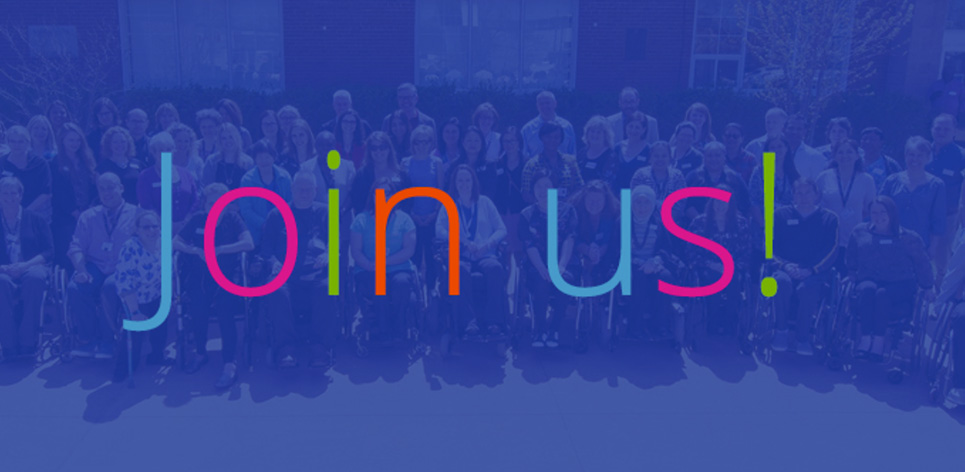Sound research is critical in shaping the experience and opportunities of those with spinal cord injury. We believe in collaboration to achieve optimal results and are proud of the research we’ve produced and funded over the years.
Here is just some of the work we’ve done in collaboration with globally-renowned researchers in the field of SCI.
Journal: Translational Behavioral Medicine
Authors: Kathleen A. Martin Ginis, Amy Latimer-Cheung, Sonya Corkum, Spero Ginis, Peter Athanasopoulos, Kelly Arbour-Nicitopoulos, Heather Gainforth
Lay Summary: This paper described the formation of SCI Action Canada – a multi-disciplinary team working towards the common goal of increasing physical activity for people living with spinal cord injury (SCI). The team consists of researchers from Canadian universities in a number of topics (e.g. exercise science, behavioural science, rehabilitation science, psychology, statistics), community, non-government organizations (e.g. SCI Ontario, Ontario Neurotrauma Foundation), and government partners, and people living with SCI. SCI Action Canada used an integrated knowledge translation approach with its partners (i.e. working in partnership all throughout the entire research process, not just at certain) to carry out research projects that addressed the following principles:
Working in a multi-disciplinary partnership resulted in a number of benefits, including:
The paper also describes a number of challenges, opportunities, and lessons learned from the formation of SCI Action Canada:
Authors: James Milligan, Joseph Lee, Matt Smith, Lindsay Donaldson, Peter Athanasopoulos, Kent Bassett-Spiers, Jeremy Howcroft, Jennifer W. Howcroft, Tara Jeji, Phalgun B. Joshi, Upender Mehan, Vanessa Noonan
Journal: Journal of Spinal Cord Medicine
Lay Summary: This study describes the development, execution, and outcomes of a one-day meeting between key individuals and organizations invested in improving access to primary and community care for people living with spinal cord injury (SCI). The meeting took place in Toronto, Ontario on November 23rd, 2016. The meeting was organized by 12 people from the following organizations: Centre for Family Medicine Mobility Clinic, Spinal Cord Injury Ontario, Ontario Neurotrauma Foundation, and the Rick Hansen Institute. The meeting was designed around the following three objectives:
Ninety-five (95) people (including health care providers, researchers, policymakers, SCI organizations, people living with SCI) attended the meeting. The meeting was led by an official facilitator and consisted of numerous presentations, panel discussions, and working group activities. Discussions from the meeting focused on five areas: knowledge translation, how to apply best practices, communication, research, and access to services. Across the five topics, a lack of knowledge, awareness, education, communication, advocacy, and funding were identified as barriers to accessing and improving primary and community care. The barriers were addressed with a number of solutions including creating networks to share knowledge, engaging people with SCI through participation in working groups, and continuing to raise awareness through all members of the SCI community (researchers, policymakers, people with lived experience, health care providers). Follow-up events that continued to bring together the different members of the SCI community allowed for further advancements in research, care and innovation to be made beyond the one-day meeting.
Journal: Disability and Rehabilitation
Authors: Mark R. Beauchamp, Louisa J. Scarlett, Geralyn R. Ruissen, Catherine E. Connelly, Christopher B. McBride, Sheila Casemore, Kathleen A. Martin Ginis
Lay Summary: Transformational Leadership Theory (TLT) focuses on concepts such as promoting values using enthusiasm and optimism, encouraging creativity and problem-solving, acting as a role model, and treating people as unique individuals. Using concepts of TLT, 15 mentees (people who receive peer support) were recruited from both SCI BC and SCI Ontario, and were interviewed to further understand the nature of effective peer support for adults living with spinal cord injury (SCI). The research team found that effective peer support aligned closely with core concepts of TLT. When a peer mentor used TLT-based behaviours, mentees seemed to report higher levels of different positive outlooks and behaviours (e.g. motivation, confidence, engagement in life activities).
Journal: Rehabilitation Psychology
Authors: Robert B. Shaw, Chris McBride, Sheila Casemore, Kathleen A. Martin Ginis
Lay Summary: 12 spinal cord injury (SCI) peer mentors (from both SCI British Columbia and SCI Ontario) were interviewed about their experiences as a peer mentor. The research team looked to see if the behaviours of the peer mentors aligned with Transformational Leadership Theory (TLT). TLT focuses on concepts such as promoting values using enthusiasm and optimism, encouraging creativity and problem-solving, acting as a role model, and treating people as unique individuals. The research team found that the behaviours of SCI peer mentors did align with the central concepts of TLT, and found an additional sub-concept called “active promotion of achievement” (doing activities alongside a mentee, instead of verbal encouragement), which may be unique to SCI peer support.
Authors: Chad Debison-Larabie, Peter Athanasopoulos, Ruth Wilcock, Judith Gargaro
Lay Summary: This poster discusses the development of Brain Injury Speaks, the Stakeholder Engagement Network for Ontario. Currently, the network is aiming to improve how issues with acquired brain injury (ABI) are being addressed across Ontario; as only local/regional issues is larger areas (e.g.) are somewhat understood. Development of this network is a promising first step in making sure that the needs of people living with an ABI are met, regardless of where they live in Ontario. The network consists of 3 key roles:
1) Regional Coordinators (work to grow the network specific to their region) ,
2) Steering Committee (oversees activities to promote growth, direction, and maintenance of the network), and
3) Stakeholder Engagement (promote and support communication between regional coordinators). Currently the network has 310 stakeholders (people with lived experience and family members).
The network will continue to work towards addressing issues the following five topics: supports, services, insurance, income and housing.
Journal: Journal of Spinal Cord Medicine (Special Edition: Abstracts from the 2012 National SCI Conference)
Authors: Sandra Mills, Jennifer Yee, Sheila Casemore
Summary: Spinal Cord Connections (SCC), was develop through a partnership between the Toronto Rehabilitation Institute (UHN) and Spinal Cord Injury Ontario. The SCC acts as a resource centre and website for people living with spinal cord injury (SCI) and their families. For this study, a balanced scorecard* (a tool used by managers that allows them to keep track of activities by their staff, and outcomes of these activities) was created to monitor SSC objectives and outcomes for people that used SCC. There were a number of benefits from using the balanced scorecard. For example, using the scorecard allowed for research to be put into practice more easily during web-conferences, and the scorecard made it easier for the SSC to communicate how they were doing to users and partner organizations. In summary, the balanced scorecard was deemed useful for management and decision making for this partnership, and is supportive in allowing the SSC to provide quality service, information, and education to clients.
Journal: Journal of Spinal Cord Medicine (Special Edition: Abstracts from the 2012 National SCI Conference)
Authors: Sandra Mills, Jairus Pryor, Sheila Casemore, Gillian Lynn-Davis
Summary: In order for websites to meet the Accessibility for Ontarians Disability Act (AODA),
websites must follow Web Content Accessibility Guidelines (WCAG 2.0). This poster describes how the Spinal Cord Connections (SCC) website, developed through a partnership between UHN and Spinal Cord Injury Ontario, was re-vamped to meet ADOA standard, and improve usability of the website for people living with SCI. Content from the website came from professionals working with people with SCI, as well as other recognized websites. To look at usability, interviews with people with SCI were conducted until consistent feedback was received (this ended up being 6 interviews total). All participants in the interviews found the website easy to use, well-designed, and informative. In addition, each of the participants stated they would strongly recommend the website to other people living with SCI. The website was also tested and was found to be compatible with a number of devices and assistive technologies. In conclusion, the re-vamp of the SCC website is a great starting point to ensure the website focuses on the needs of people living with SCI.
Authors: Lindsay Sleeth, MSc.; Sonya Allin, Ph.D.; Karen Anzai, BSR (OT/PT); Peter Athanasopoulos; Susan Jaglal, Ph.D.; Gary Linassi, MD3; Sarah Sarah Munce, Ph.D.; Vanessa Noonan, Ph. D.; John Shepherd, MBA; Jennifer Tomasone, Ph.D.; Dalton Wolfe, Ph.D.
Authors: Lindsay Sleeth, MSc.; Sonya Allin, Ph.D.; Karen Anzai, BSR (OT/PT); Peter Athanasopoulos; Susan Jaglal, Ph.D.; Gary Linassi, MD; Sarah Munce, Ph.D.; Vanessa Noonan, Ph. D.; John Shepherd, MBA ; Jennifer Tomasone, Ph.D.; Dalton L. Wolfe, Ph.D.
Participating in ethical research studies can be a rewarding experience, and is a great way to help move science forward. Learn more about the current opportunities available and how you can participate today.
Learn more about the ways to connect with our community to further research by becoming an SCIO Research Partner OR by investing in our Research Promotion Package.
Are you ready to kickstart your fundraiser? Fill out the form, and we’ll send you our comprehensive Fundraising Toolkit along with any other materials you might need.

Just say “Yes! Sign me up!” and you can improve accessibility in Ontario and help us serve, support and advocate for and with people with spinal cord injury and other disabilities.
There really is strength in numbers.

Please complete this form and we will contact you after receipt to confirm participation, obtain complete details about your study including any supporting materials, and answer any questions.
"*" indicates required fields